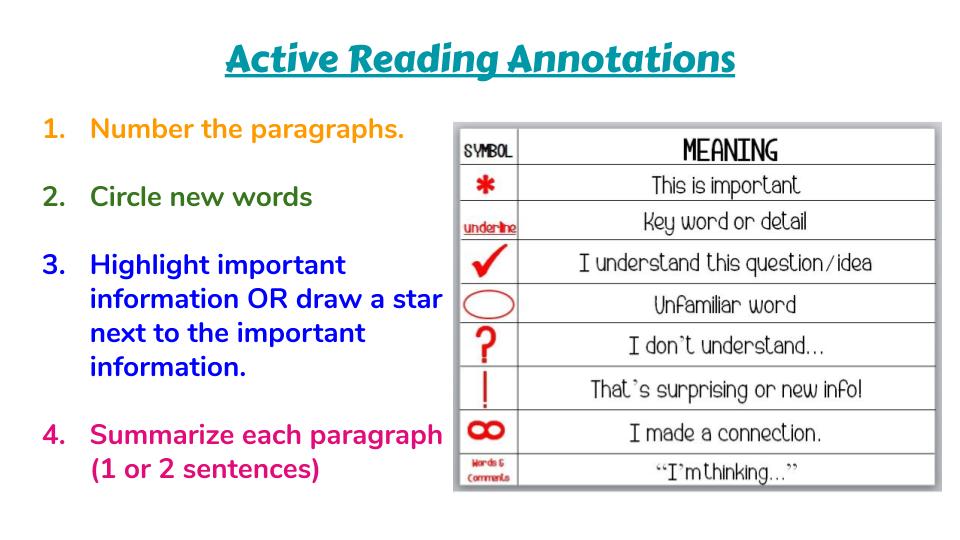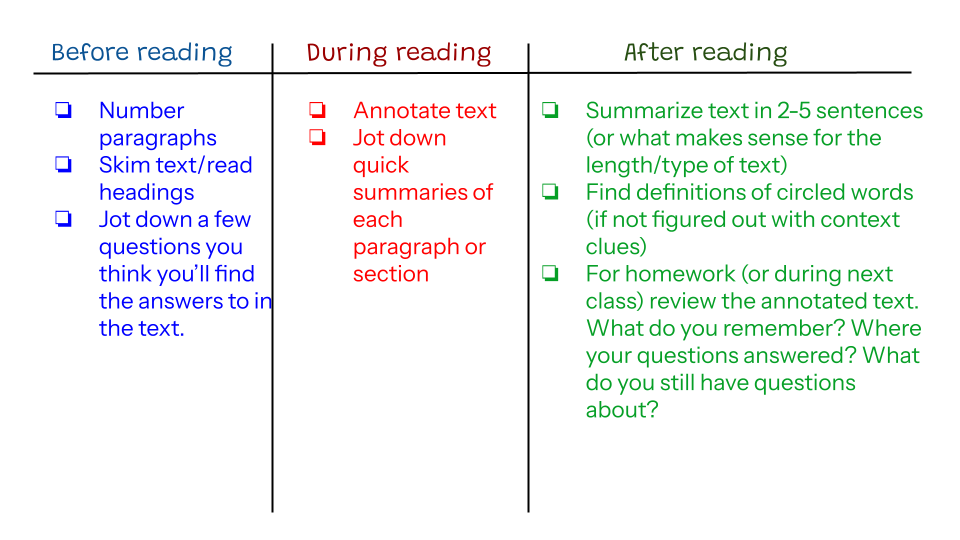Imagine that you’re reading a book about an unfamiliar topic. It could be for leisure or not. When you read, how do you interact with the text? What do you do when encountering a word or phrase you don’t understand? Do you write questions for the author in the margins? How you answer these questions determines whether you tend to read actively or passively. When your students read, they are most often reading passively, because that’s what they know. We have to teach them how to interact with the text in a way that will make it more accessible to them. Most of us need to be taught how to read actively and why it’s beneficial. As you teach active reading strategies, it’s important to make it clear to your students that one style of reading isn’t better than the other, but “different strategies are effective with different types of texts” (McPherson). For example, I do not typically write notes and questions in the margins when I read for leisure. I’m mostly reading passively, except to define a word and sometimes write the definition in the book. When we’re reading to learn, it’s more helpful to read actively. This means you are “having a conversation” with the text. That conversation can help you develop a deeper understanding of the text or topic.
Active reading does not typically come naturally; it’s a skill that must be learned and practiced. Luckily, it’s a skill that it’s never too late to learn. Often, students don’t know any effective reading strategies until it is taught to them in college (Corrigan). You can shorten this learning curve by teaching your students the value of active reading strategies. They should learn that when they read carefully, they are more likely to understand and respond in ways that we want them to (Corrigan).
Active reading is only a technique; it’s not the answer to all of the ills plaguing American public education. But, teaching your students this technique can encourage readers to slow down and pay attention to how they read and learn (Corrigan). Students often give up on a text if they don’t understand it after reading it once. Teaching these reading strategies trains them to read texts more than once and develop perseverance.

The Strategy
This strategy was taught to me during my second year of teaching, but it is modified from the strategy laid out by Peter Barry in his book Beginning Theory. Paul Corrigan quoted the book in his article Attending to the Act of Reading: Critical reading, contemplative reading, and Active Reading.
Before reading
Get students thinking first. Have them number paragraphs and read the section titles if present. Have them think about what they might learn from the article. Introduce tier three words that might be the most challenging for your students (foldable, vocabulary sheet, etc.).
During reading
Annotate the text:
- Number paragraphs first
- Circle new words. Find definitions after reading if context clues did not help
- Underline/highlight important passages
- Draw “?” next to ideas you have questions about
- Write questions in the margins/where there is space as you read

After reading
Students should summarize the text after they have read the text. I consider this part to be the most important because students’ ability to summarize a text indicates their understanding of it. This can be challenging depending on your students’ grade level but it’s such a valuable skill to develop. Either have your students summarize the whole text or write small summaries for each paragraph/section. Paragraph summaries can be 1-2 sentences long. Whole text summaries can be 2-5 sentences long.

Sources
Corrigan, Paul T. “Attending to the Act of Reading: Critical reading, contemplative reading, and Active Reading.” Reader: Essays in Reader-Oriented Theory, Criticism, and Pedagogy, vol. 63-64, no. 63-64, 2012, pp. 146-173. Fire Scholars, https://firescholars.seu.edu/seu_papers/2/. Accessed 14 June 2024.
McPherson, Fiona. “Active reading: A collection of articles on reading from the Mempowered website.” Mempowered, 2024, https://www.memory-key.com/archive/. Accessed 14 June 2024.






